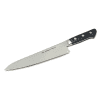Preventing Wooden Cutting Boards from Cracking
Over time, wooden cutting boards may start to look dull and dry. How can they be kept lustrous and free of cracks?
Wooden cutting boards need to be washed in hot soapy water to keep them clean and safe (some people use a diluted bleach solution, but we’ve found that isn’t necessary), but over time this treatment takes a toll. Repeated wetting and drying can make wood fibers rough and dry, and eventually the wood may warp or even split. You could use a plastic board, but we prefer the feel of wood.
To keep wooden cutting boards in great shape, we recommend rubbing them with food-grade mineral oil (available at most drugstores and hardware stores) every few months. The wood soaks up the mineral oil, creating a barrier to water. Most wooden cutting boards require oiling six or seven times a year (depending on how frequently they are used and washed). Don’t use olive or vegetable oil, which can become rancid and can make the food that comes into contact with the board taste bad. Our favorite cutting board, the Proteak Edge Grain Teak Cutting Board, requires less oiling because teak (a tropical wood often used in shipbuilding) contains compounds that are naturally resistant to moisture.
THE BOTTOM LINE: Give your wooden cutting boards a moisture-blocking coat of food-grade mineral oil when they’re new and every month after that. Or pick up the Proteak Edge Grain Teak Cutting Board ($85), which is naturally moisture-resistant and should require oiling only once or twice per year.
FOOD-GRADE MINERAL OIL: Prevents the moisture damage that can eventually make wooden boards crack.
PROTEAK EDGE GRAIN TEAK CUTTING BOARD: At $85, our favorite cutting board is a hefty investment, but you won't have to oil it that frequently.


